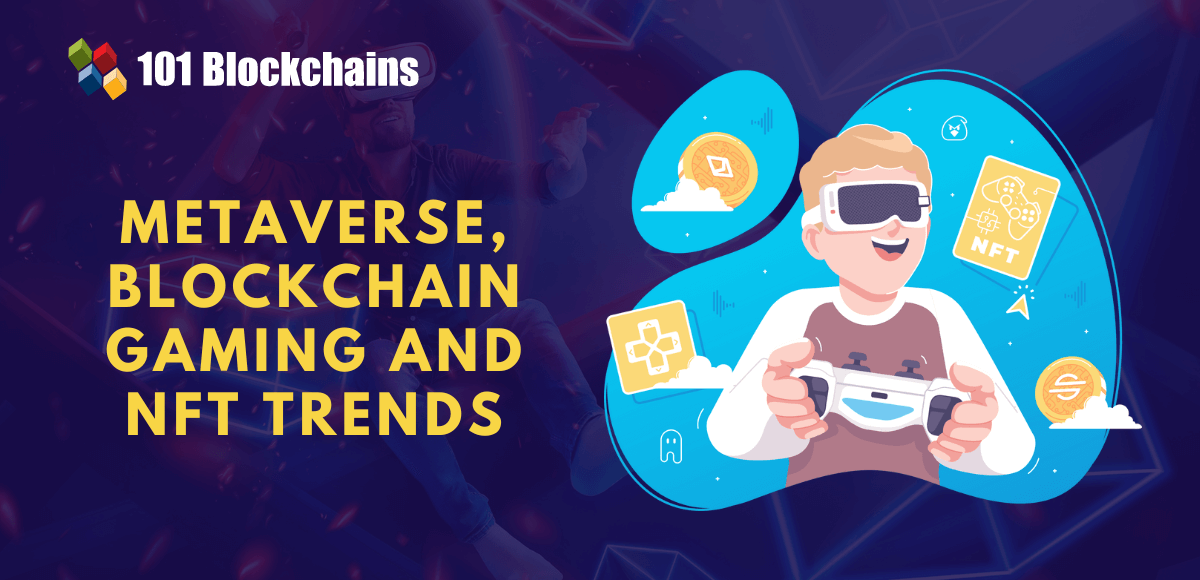Learn how blockchain truly works, master key definitions, and uncover what makes smart contracts so "smart." Dive into the fundamentals, gain valuable insights, and start your blockchain journey today!

- Metaverse
James Howell
- on November 28, 2023
How Augmented Reality Works in the Metaverse?
The transition of Facebook to Meta in 2021 created a lot of hype about the metaverse. Within a few months, the term ‘metaverse’ became one of the most searched terms on the internet. The discussions about augmented reality in metaverse reflect on the importance of different components for developing the metaverse. Augmented reality and virtual reality are the two immersive technologies that help you access the metaverse.
It provides an alternative to the physical reality with flexibility for engaging with different virtual spaces in the form of digital avatars. Augmented reality has been gaining popularity for its broad range of applications in different use cases. Forecasts have predicted that the world will have more than 1.7 billion AR devices all over the world by 2024. How will AR influence the metaverse? Let us take a look at the importance of AR in the metaverse with its different use cases.
Definition of Augmented Reality
Augmented Reality refers to the technology used for augmenting reality. AR could help users experience the physical world with enhancements in the form of interactive digital elements. The explanation for augmented reality working mechanisms shows that AR apps could offer auditory and visual information within real-world ecosystems. Some of the common AR apps could work without interruption on smartphones. Users could leverage the AR apps to improve the experience of interacting with the physical world.
Augmented Reality could help in adding different digital overlays to the real world. The metaverse augmented reality equation could utilize digital overlays to expand the immersive metaverse experiences. Some of the examples of digital overlays in the real world with AR include,
- Variation of colors depending on changes in situations.
- Addition of labels.
- Inserting real-time directions with navigation apps.
- Modification of user appearance or the environment by utilizing filters on Instagram and Snapchat.
- Superimposition of 3D models, images, and other digital information on real-world objects and surroundings.
Augmented reality serves as the ideal companion for virtual reality in metaverse for providing an enhanced representation of the physical world. You would need gadgets, such as AR glasses or a headset, to access the functionalities of AR in metaverse. Interestingly, some of the advanced versions of such glasses also allow the flexibility for interactions with virtual elements, known as mixed reality.
For example, you can imagine wearing AR glasses and looking for all the information about products with one look. Similarly, you could also use AR glasses in metaverse shopping to visualize how you would look in your clothes. The glasses would add the clothing design as a digital overlay on your body, which would introduce a revolutionary transformation in the online purchase process.
Want to get an in-depth understanding of metaverse concepts? Enroll now in Metaverse Fundamentals Course
Variants of Augmented Reality
The review of fundamental implications of augmented reality shows that AR has the potential to revolutionize conventional digital experiences. However, you can learn about augmented reality use cases and how they deliver value by exploring different AR variants. Here are some of the notable variants of augmented reality that can help you determine the design of AR use cases in metaverse.
-
Marker Augmented Reality
Marker-based AR systems are the conventional form of AR. In this variant, devices could capture images and use image processing alongside marker tracking to identify the ideal position for placing virtual objects. The images already exist in the database, and the AR system utilizes the position alongside orientation of marked objects for effective identification. The most notable example of marker-based AR points at Instagram and Snapchat filters. Users could capture real-time images in their cameras, and markers help in identifying the ideal position for placing filters.
-
Markerless Augmented Reality
The next type of AR system is markerless AR system. Markerless augmented reality does not feature programmed images or objects for facilitating recognition. The answers to “What are the use cases of AI in metaverse?” would help you identify effective ways for using markerless augmented reality.
It supports navigation applications, businesses, and events. The markerless augmented reality systems utilize location-based information to identify what the user searches for in a specific location. Markerless augmented reality leverages technologies such as accelerometers, GPS, and gyroscopes. Here are the different variants of markerless augmented reality.
- Location-based Augmented Reality
- Superimposition-based Augmented Reality
- Projection-based Augmented Reality
- Contour-based Augmented Reality
Enroll now in the Metaverse Technology Course to learn about the technologies underlying the desired features of the metaverse.
Working Mechanisms for Augmented Reality
The definition of augmented reality shows a brief glimpse of how it works. It creates overlays of virtual objects on real-world objects, people, and surroundings. As a result, they could generate interactive worlds with the facility for seamless interaction between digital and physical worlds. Here are the important aspects of the working mechanism of augmented reality in metaverse, which explain how AR delivers value in the metaverse.
-
Sensors and Cameras
The most crucial component in augmented reality hardware points at sensors, which help the AR algorithm understand its surroundings. Augmented reality applications could help in determining the accurate location and orientation of an individual or an object. The use cases of AR would leverage a combination of technologies such as gyroscopes, cameras, GPS, and accelerators. Subsequently, it can help in adding virtual elements to the physical environment.
-
Algorithms
The explanation for augmented reality working mechanisms also shows that AR systems map the physical environment through machine learning. In addition, image processing techniques are also a crucial highlight of the AI algorithms, which determine the ideal position for placing virtual objects. Machine learning algorithms are an essential requirement for ensuring that the AR systems can function according to desired use cases.
-
Output Devices
Another notable addition among the components in the working of augmented reality refers to output devices. The devices could help users in viewing virtual objects. One of the most notable examples of an output device for AR systems is the head-mounted display or headset. Individuals also use their phones to explore the functionalities of augmented reality.
Metaverse can become the next big break in our technological advancements. Learn more about the future of Metaverse now with Is Metaverse The Next Big Thing Presentation
Applications of AR in the Metaverse
The next important highlight in understanding the significance of metaverse augmented reality would refer to the use cases. Metaverse will become a major platform for digital experiences in the future. Therefore, you can envision digital user experiences for almost every sector through the metaverse. Here are the applications of AR in different sectors within the metaverse.
-
Architecture
The benefits of visualization could help in supporting the use cases of architecture design. AR could help in determining the ideal furniture for interior design of your home. Augmented Reality could help in visualizing the appearance of wall colors and hangings. On top of it, you can also visualize the appearance of other elements in the architecture of your home.
-
Healthcare
The references to questions like “What are the use cases of AI in metaverse?” also draw attention toward healthcare. Augmented reality has become an important component in the field of medical training and education. It can assist students and healthcare professionals in accurate visualization of human anatomy.
In addition, it also offers the flexibility for scanning MRIs and other scan images from unique perspectives. For instance, learners can find important information about a surgical process from the real-time perspective of a surgeon during an actual procedure.
-
Tourism
The applications of AR in the metaverse would also support new applications in the tourism and hospitality sectors. Users can rely on AR in the metaverse to learn more about the destinations they want to visit. You can think of such augmented reality use cases as an alternative tour guide who helps you explore the attractions in new countries. Augmented Reality could help in introducing a completely new transformative experience in tourism.
-
Retail Market
The impact of augmented reality on improving the metaverse would also point to the use cases for the retail market. Users could view 3D representations of different products before purchasing them. In a way, AR could help in resolving the concerns of consumer apprehensions during virtual shopping. For instance, you could find out how you would look in a specific dress before purchasing it.
-
Education
The use cases of AR in metaverse would also help in transforming the education sector. Augmented reality can help transform modern classrooms with interactive learning experiences that allow students to learn through virtual elements. Such examples of augmented reality in metaverse show that it could improve interest in the curriculum alongside retention of learners. Learners are more likely to pay attention in a class about the solar system with virtual overlays of planets.
Start learning the fundamentals of the metaverse with World’s first Metaverse Skill Path with quality resources tailored by industry experts Now!
How is Augmented Reality Different from Virtual Reality?
The fundamental concepts related to applications of AR in the metaverse also invite curiosity regarding the impact of virtual reality. How are the applications of virtual reality in metaverse different from AR? As the name implies, virtual reality is completely virtual, while AR utilizes real-world surroundings. Both technologies are crucial for the development of metaverse and interactions with it. Virtual reality offers experiences that can help in replacing the existing physical surroundings with simulated environments.
On the other hand, augmented reality denotes the physical reality you witness around you. However, it has an additional layer of information. The most important highlight of AR is the fact that any individual can experience augmented reality through smartphones. Augmented reality focuses on magnifying the value of user experiences in the metaverse.
Want to know about the key elements of the Metaverse ecosystem? Check out Introduction To Metaverse E-Book
Importance of Augmented Reality for Metaverse
The different use cases of AR in metaverse prove that augmented reality could offer promising benefits for transforming reality. You can use augmented reality and metaverse as isolated technologies, albeit with possibilities for using them together for more advantages. The explanation for augmented reality working mechanisms in metaverse highlights the role of metaverse as a digital landscape that allows participants to create personalized virtual spaces. You should learn about the metaverse and how it features a network of different virtual spaces accessible through VR glasses and headsets. How does augmented reality influence the metaverse?
The metaverse helps in visualizing the physical reality from a different perspective. However, no one could change the world around us. On the other hand, AR could help in adding an extra dimension to the surroundings. For example, you can utilize GPS data, texts, or images to improve your understanding of the concerned location. In addition, the spatial representation of all the elements helps in ensuring better depth perception.
Most important of all, metaverse augmented reality makes your brain believe that the virtual elements are actually present in the physical environment. As a result, users in the metaverse could find their physical reality more interesting and dynamic. Interestingly, Mark Zuckerberg has also stated that augmented reality is a vital component for translating the embodied internet to reality.
Want to learn Metaverse concepts quickly? Check out Now Metaverse Flashcards and Metaverse FAQs
Future of Augmented Reality for the Metaverse
The use of machine learning algorithms in AR systems provides a clear impression of the importance of AI for the metaverse. At the same time, you can notice how AR has a major role in transforming the metaverse into reality. The responses to ‘What are the use cases of AI in metaverse?’ and the role of metaverse in the modern digital renaissance showcase the significance of an augmented metaverse. The future of AR in metaverse would depend on continuously growing popularity of AR glasses, devices, and gaming tools. Widespread adoption of AR technologies would help in enabling the next generation of 3D experiences for users.
Smartphones would serve as the easiest way for users to familiarize themselves with applications of augmented reality. On top of it, AR could serve usability in different sectors that could expand the popularity of AR applications in the metaverse.
Wondering about how to level up your career with Metaverse expertise? Read the detailed guide Now on How To Become Metaverse Expert
Final Words
The importance of augmented reality in the metaverse revolves around the capability of AR to transform the metaverse. It helps in bringing the metaverse into the real world. In a way, the augmented reality use cases help in achieving the vision of the metaverse for bridging physical and virtual worlds.
As of now, augmented reality serves valuable outcomes in education, healthcare, and retail sectors. However, AR is still far from mainstream adoption. At the same time, the availability of AR apps is good news for adoption of augmented reality technology. Learn more about augmented reality and how it works behind the scenes to make the metaverse more engaging.






